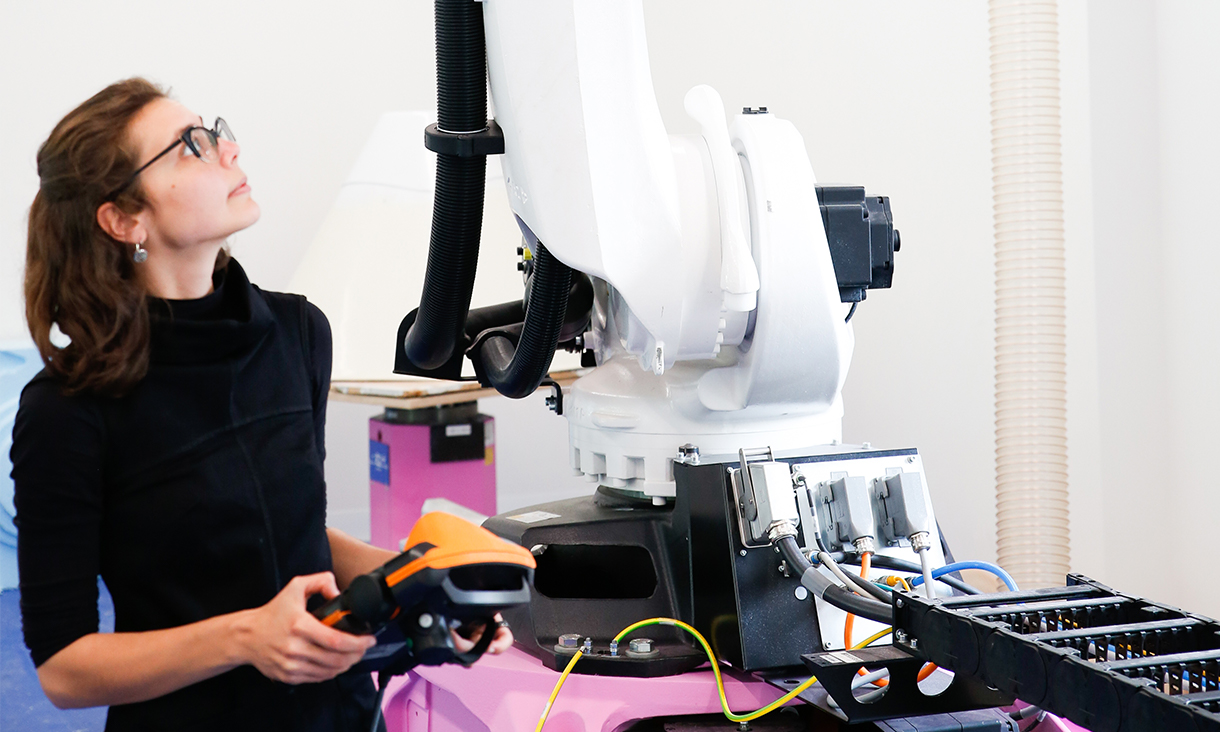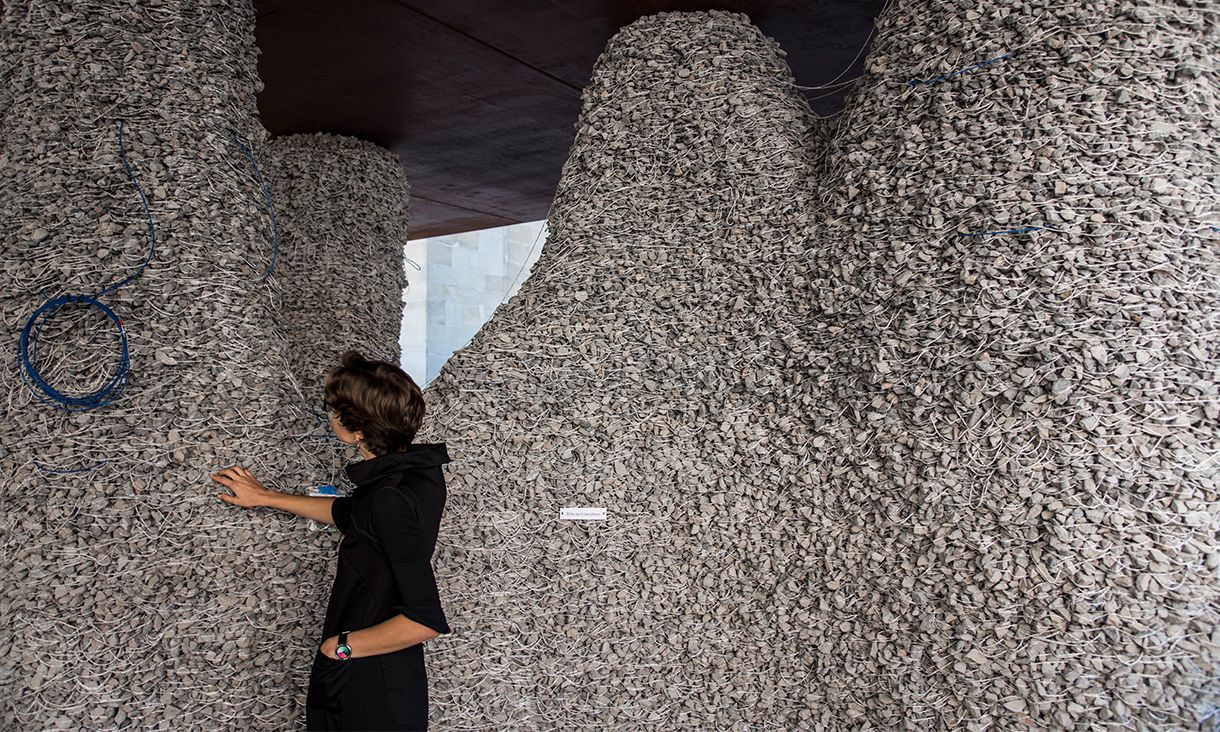New research into soil used for building

Dr Gergana Rusenova working in the Swinburne’s robotics lab, ProtoLAB. Photographed by Bailey Wentworth, Design Bureau.
In summary
- Swinburne lecturer Dr Gergana Rusenova commences an exciting joint research project into sustainable and efficient granular materials.
- The project is funded by the Australia-Germany Joint Research Cooperation Scheme.
- Dr Rusenova will use the robotic arms at Swinburne’s ProtoLAB to build a prototype in Melbourne.
Using robotic arms to build a prototype, Dr Gergana Rusenova will be breaking new ground on the use of soil in building. She has commenced an exciting joint research project with Professor Dr Karola Dierichs at Weissensee School of Art and Design, Berlin, funded by the Australia-Germany Joint Research Cooperation Scheme.
Dr Rusenova is a lecturer in architecture in the School of Design. For this project on textile-reinforced granular materials, she’ll be drawing on her expertise in how granular materials are used in architectural structures.
“With the support of the Australia-Germany Joint Research Cooperation Scheme this year, Professor Dr Dierichs and I will be looking at soil as a granular material. Existing techniques such as rammed earth require cement to be added to the soil mix. This building technique is labour-intensive, time-consuming and expensive.
“Our collaboration with Weissensee School of Art and Design involves using the robotic arms at Swinburne’s ProtoLAB to build a prototype in Melbourne. We’ll investigate alternative computational design techniques and how to automate the production by using advanced manufacturing methods,” Dr Rusenova says.
Dr Rusenova worked on her Masters thesis at the University of Stuttgart where she delved into the physical versus virtual behaviour of granular matter. Images by Gergana Rusenova.
“I have worked on simulations of this non-standard building material and constructed a mechanical device to connect digitally simulated behaviours with the structural performance of physical prototypes. The device facilitates this connection in real time,” explains Dr Rusenova.
Building with sustainable materials
For Dr Rusenova, the beauty of granular materials is the reversible logic behind them. They represent a different branch of building materials that solidify based only on the interaction between the individual particles.
“There is no need for permanent bonding, and structures built with them can be fully recycled. For example, grains of sand are not bonded to each other but still manage to form a pile. In the context of the built environment, the challenge is to move away from the pile and build functional and simultaneously, reversible architectural elements,” she explains.
She is interested in finding ways to use materials that already exist, rather than using lots of energy, time and resources to manufacture new materials that cannot be easily recycled.

Dr Rusenova stands in front of the Rock Print Pavilion at Kirchplatz, Switzerland which formed part of her PhD project with Gramazio Kohler Research, ETH Zurich. Image by Martin Rusenov.
Creating architectural structures
In 2016, Dr Rusenova joined the group of Gramazio Kohler Research at ETH Zurich to further investigate recyclable materials as part of an ongoing research project called ‘Jammed Architectural Structures’.
“We stacked alternating layers of loose stones and textile string, arranged in loops, to create three-metre-tall structures. In 2018, we built a large-scale loadbearing structure as part of a public outdoor exhibition called ‘Hello, Robot!’ at the Gewerbemuseum Winterthur. The structure was assembled with a mobile robotic arm programmed in collaboration with researchers at ETH Zurich,” she says.
Dr Rusenova worked with architecture students in Swinburne’s ProtoLAB. Image by Bailey Wentworth, Swinburne Design Bureau.
“Simulations and the use of robotics underpin how we will build and dismantle our structures, but the greater focus is about how we can create something new, and how we can create something that is better for the universe, for the environment,” says Dr Rusenova.
-
Media Enquiries
Related articles
-

- Design
Swinburne alum launches zine celebrating Asian Australian art and identity
Swinburne Graphic Design alum Dan Truong founded HOISZN, a zine publication showcasing Asian Australian artists and their work.
Monday 01 July 2024 -

- Design
Swinburne students shine in lighting design collaboration
Swinburne students collaborated with About Space Lighting, resulting in several student-designed lamps being put into production.
Friday 07 June 2024 -

- University
Swinburne University of Technology partners with Grande Experiences and THE LUME Melbourne for cutting-edge Immersive Media education
Swinburne University of Technology is proud to announce its partnership with Grande Experiences and THE LUME Melbourne, enhancing the future of Immersive Media education.
Thursday 13 June 2024 -

- Design
Yarra Trams feature Women in Trades campaign designed by Swinburne students
School of Design and Architecture students in Swinburne’s Bureau collaborated with Tradeswomen Australia Group to design a tram wrap celebrating women in trades.
Thursday 16 May 2024 -

- Design
- Astronomy
- Technology
- University
Swinburne ‘Rock Muncher’ takes part in Australian Rover Challenge
A multidisciplinary student team from Swinburne University of Technology competed in the 2024 Australian Rover Challenge held in Adelaide, South Australia.
Thursday 11 April 2024







